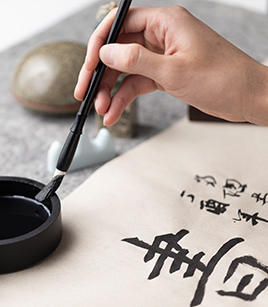Chinese calligraphy

Chinese calligraphy is the stylized artistic writing of Chinese characters. Photo: CFP
Chinese calligraphy is the stylized artistic writing of Chinese characters, including several major styles.
Oracle bone inscriptions used during the Shang Dynasty (c. 1600–1046 BCE) are identified as the earliest form of Chinese characters. This writing style was followed by a form of writing found on bronze vessels mainly cast during the Shang and Zhou (c. 1046–256 BCE) dynasties. These bronze inscriptions were known as jinwen (bronze inscriptions).
Zhuanshu, or seal script, evolved out of bronze inscriptions toward the end of the Zhou Dynasty. There are two kinds of seal scripts: dazhuan (large-seal script) and xiaozhuan (small-seal script). Dazhuan is a traditional reference to all types of Chinese writing systems used before the Qin Dynasty (221–207 BCE). After China was united for the first time, xiaozhuan was developed and adopted as the formal script for the whole country. This script features an even line-weight, many curves, and circles.
The growing demand for recordkeeping gave rise to the fourth stage of development in Chinese calligraphy, lishu, or clerical script, which was most widely used in the Han Dynasty (206 BCE–220 CE). Characters transcribed in clerical script style tend to be square or rectangular, with a greater width than height. They often have a wavelike flaring of isolated major strokes.
The birth of kaishu, or regular script, marked the fifth stage of development in Chinese calligraphy. This script was developed during the Wei, Jin, Southern and Northern Dynasties (220-589), simplifying the clerical script into a more fluent and easily written form. Regular script remains the standard script in use today.
Also born during the Han Dynasty, the xingshu (running script) and caoshu (cursive script) were the results of rapidly writing. The cursive script features vibrating strokes that are connected with each other. It is hard to identify without a given context. The running script is a style between regular script and cursive script. It is easy to recognize and is fluent and practical. However, these two styles have never been thought of as standard writing because of their many variations. Instead, they have been used as a form of art.
Edited by REN GUANHONG
